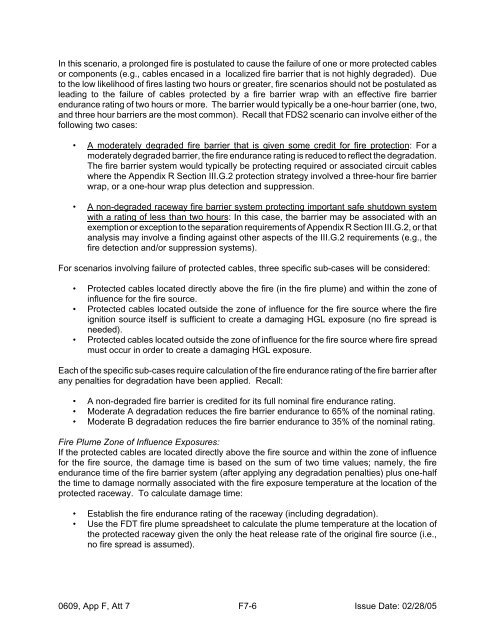IMC 0609, App F, Att 7 - NRC
IMC 0609, App F, Att 7 - NRC
IMC 0609, App F, Att 7 - NRC
Create successful ePaper yourself
Turn your PDF publications into a flip-book with our unique Google optimized e-Paper software.
In this scenario, a prolonged fire is postulated to cause the failure of one or more protected cables<br />
or components (e.g., cables encased in a localized fire barrier that is not highly degraded). Due<br />
to the low likelihood of fires lasting two hours or greater, fire scenarios should not be postulated as<br />
leading to the failure of cables protected by a fire barrier wrap with an effective fire barrier<br />
endurance rating of two hours or more. The barrier would typically be a one-hour barrier (one, two,<br />
and three hour barriers are the most common). Recall that FDS2 scenario can involve either of the<br />
following two cases:<br />
• A moderately degraded fire barrier that is given some credit for fire protection: For a<br />
moderately degraded barrier, the fire endurance rating is reduced to reflect the degradation.<br />
The fire barrier system would typically be protecting required or associated circuit cables<br />
where the <strong>App</strong>endix R Section III.G.2 protection strategy involved a three-hour fire barrier<br />
wrap, or a one-hour wrap plus detection and suppression.<br />
• A non-degraded raceway fire barrier system protecting important safe shutdown system<br />
with a rating of less than two hours: In this case, the barrier may be associated with an<br />
exemption or exception to the separation requirements of <strong>App</strong>endix R Section III.G.2, or that<br />
analysis may involve a finding against other aspects of the III.G.2 requirements (e.g., the<br />
fire detection and/or suppression systems).<br />
For scenarios involving failure of protected cables, three specific sub-cases will be considered:<br />
• Protected cables located directly above the fire (in the fire plume) and within the zone of<br />
influence for the fire source.<br />
• Protected cables located outside the zone of influence for the fire source where the fire<br />
ignition source itself is sufficient to create a damaging HGL exposure (no fire spread is<br />
needed).<br />
• Protected cables located outside the zone of influence for the fire source where fire spread<br />
must occur in order to create a damaging HGL exposure.<br />
Each of the specific sub-cases require calculation of the fire endurance rating of the fire barrier after<br />
any penalties for degradation have been applied. Recall:<br />
• A non-degraded fire barrier is credited for its full nominal fire endurance rating.<br />
• Moderate A degradation reduces the fire barrier endurance to 65% of the nominal rating.<br />
• Moderate B degradation reduces the fire barrier endurance to 35% of the nominal rating.<br />
Fire Plume Zone of Influence Exposures:<br />
If the protected cables are located directly above the fire source and within the zone of influence<br />
for the fire source, the damage time is based on the sum of two time values; namely, the fire<br />
endurance time of the fire barrier system (after applying any degradation penalties) plus one-half<br />
the time to damage normally associated with the fire exposure temperature at the location of the<br />
protected raceway. To calculate damage time:<br />
• Establish the fire endurance rating of the raceway (including degradation).<br />
• Use the FDT fire plume spreadsheet to calculate the plume temperature at the location of<br />
the protected raceway given the only the heat release rate of the original fire source (i.e.,<br />
no fire spread is assumed).<br />
<strong>0609</strong>, <strong>App</strong> F, <strong>Att</strong> 7 F7-6<br />
Issue Date: 02/28/05
















